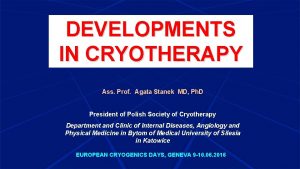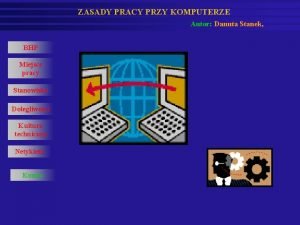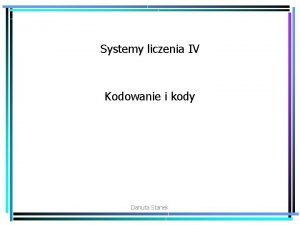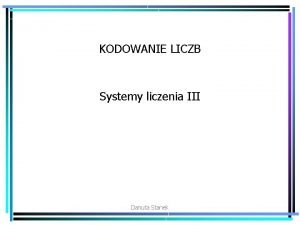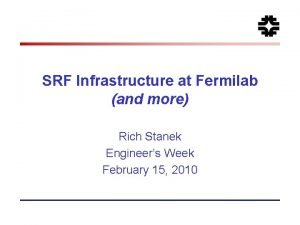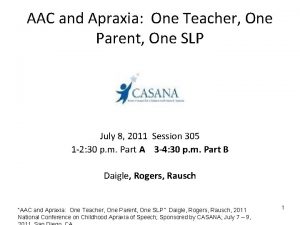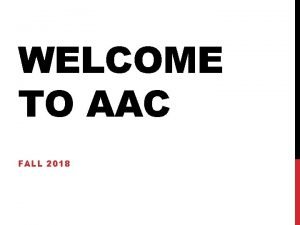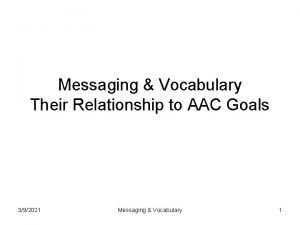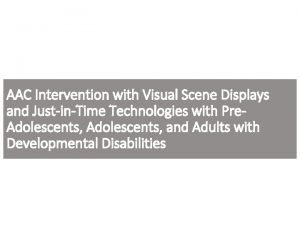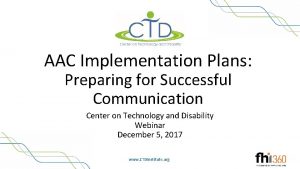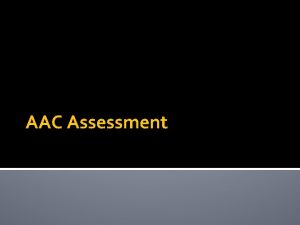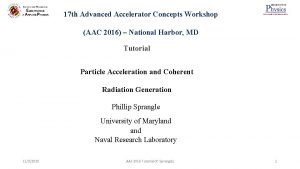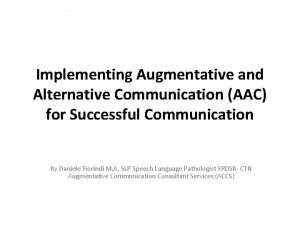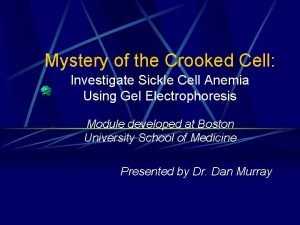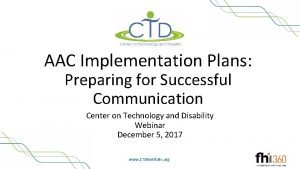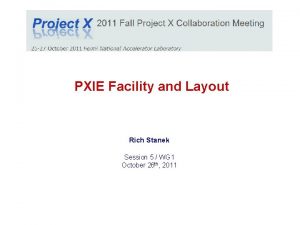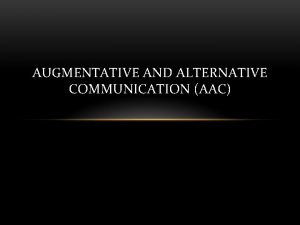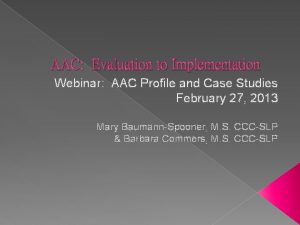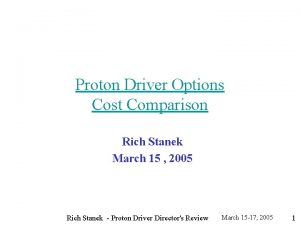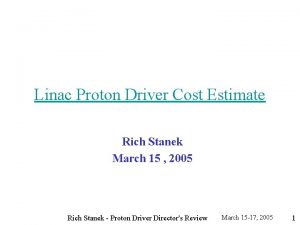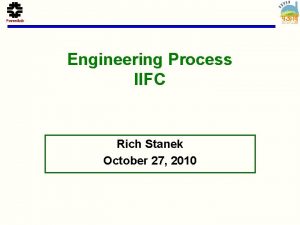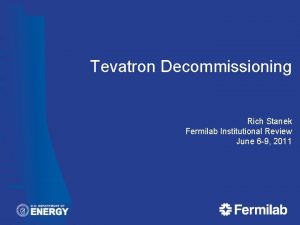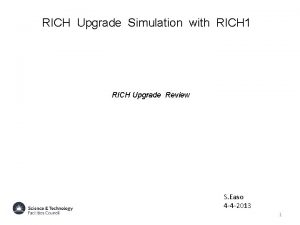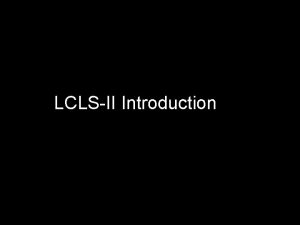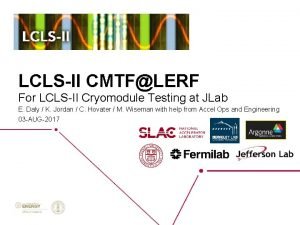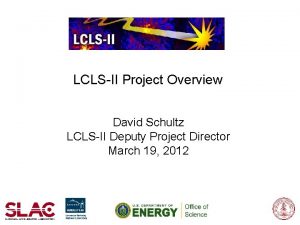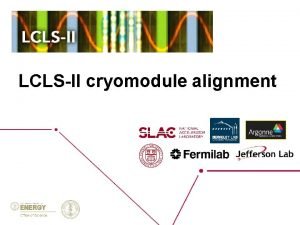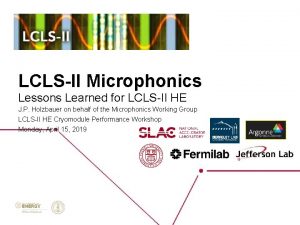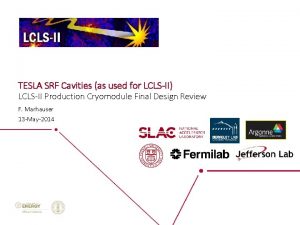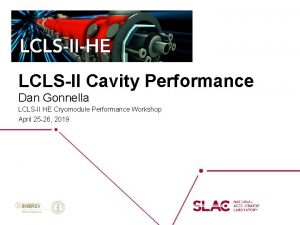LCLSII and LCLSII HE Rich Stanek AAC 2019



















- Slides: 19

LCLS-II and LCLS-II HE Rich Stanek AAC 2019 21 November 2019

Outline • LCLS-II – – Scope/Remaining Work Status Results Lesson Learned • LCLS-II HE – Scope of Work – Status – Results • Working in Perfect Harmony – Staff & Infrastructure 2 R. Stanek | AAC 2019 11/20/2019

LCLS-II Original Scope of Work • Fermilab’s original scope of work for LCLS-II – Design 1. 3 GHz cryomodule – Fabricate & test half of the 1. 3 GHz CM (17 + 2 added) – Design 3. 9 GHz cryomodule – Fabricate & test two 3. 9 GHz cryomodules plus one spare – Design & fabricate Cryo Distribution System (CDS) • 6 Feed Caps/2 End Caps/2 Bypass TL/2 Distrib. Boxes/300 ft. Surface TL – Provide installation/commissioning support (as requested) – Assist with Accelerator Physics & LLRF control (as requested) 3 R. Stanek | AAC 2019 11/20/2019

LCLS-II Remaining Work • Fermilab’s remaining work for LCLS-II – 1. 3 GHz – 2 CMs remain (out of 17 to be delivered) • 2 CMs have been designated for possible sale to LCLS-II HE • Ship F 1. 3 -03 to SLAC (mid-Jan) • Assemble, test and ship F 1. 3 -06 (end-Jul) – 3. 9 GHz – 3 CMs remain (3 to be delivered) • Change in frequency could bring new challenges – Carry over many lessons learned from 1. 3 GHz work • Assemble, test and ship F 3. 9 -01 (end-Feb) • Assemble, test and ship F 3. 9 -02 (end-Mar) • Assemble, test and ship F 3. 9 -03 (mid-May) – Assist with interconnect work at SLAC (as requested) – Cryo Distribution System work - complete 4 R. Stanek | AAC 2019 11/20/2019

LCLS-II Status • F 1. 3 -03 testing complete prep for shipping • Change over of CMTS to 3. 9 GHz in progress • F 3. 9 -01 at WS 5 (final assembly before testing) – Move to CMTS (mid-Dec) • F 3. 9 -02 at WS 2 (out of clean room – cavity string leak tight) • 1. 3 GHz transport issues resolved routine shipping • Performing due diligence on 3. 9 GHz transportation – – – 5 Analyzing critical components Monitoring movements on site Shipping to SLAC without warm couplers Series of cavity shaker table tests successfully performed Working on dummy CM transport road test Plan for Transportation Review in January R. Stanek | AAC 2019 11/20/2019

LCLS-II CM Performance (Excellent – easily meets spec) 1 Two CMs will not be rebuilt

Lessons Learned (not all) • “almost the same” means there are still differences • even with experienced vendors “trust but verify” • design configuration management requires the use of a documented DCR process • assure there is adequate time between prototype testing and start of production to feedback changes • transportation should be analyzed for each new situation • if you want to know maximum SRF performance in CM schedule additional CM test time to process and push limits • cavity and material R&D performed in parallel with production can help catch unforeseen issues • work planning & control is critical especially for off-normal activity 7 R. Stanek | AAC 2019 11/20/2019

Bottom Line for LCLS-II • LCLS-II is approaching the end of 1. 3 GHz CM production Next phase is to assemble and test three 3. 9 GHz CM – Aware that frequency change could uncover new challenges • 1. 3 GHz performance has been excellent exceeding specifications – Gradient/CM = 158 MV (spec 128 MV) – Average Q 0 = 3 E 10 (spec 2. 7 E 10) – World-class results in a record time • Focus now shifting to installation and commissioning at SLAC – Working with SLAC on installation-related issues 8 R. Stanek | AAC 2019 11/20/2019

LCLS-II HE (slides courtesy of Anna Grassellino) • Fermilab is fully committed to deliver a beyond the state of the art SRF linac for the LCLS-II HE project, in collaboration with SLAC and JLab – Cutting edge machine which will enable new science – Pushes the SRF technology boundaries towards higher performance, in turn helping the HEP mission (e. g. PIP-II already benefitting from LCLS-2 HE R&D) – FNAL possesses unique SRF facilities and expertise key to the realization of this machine • High priority, high visibility project at the lab, weekly report STL to Director to ensure that proper resources are allocated to fulfil the scope of work on time and on budget 9 R. Stanek | AAC 2019 11/20/2019

LCLS-II HE Fermilab Scope of Work • Cryomodule Engineer of Record – design work • R&D to enable higher cavity performance (doping for high Q 0 at higher gradient), material R&D for flux expulsion, cavity multipacting R&D • Build and test the pre-production cryomodule • Build and test 10 production cryomodules • Cryo Distribution System design and procurement – New Feed Cap, End Cap, Transfer Line… 10 R. Stanek | AAC 2019 11/20/2019

LCLS-II HE Schedule 11 R. Stanek | AAC 2019 11/20/2019

FTE needs for LCLS-II HE at FNAL • Detailed analysis of SRF/cryo FTE requests/needs in the next several years is performed yearly to ensure availability of expert staff and anticipate/resolve in advance potential shortage of staff FTE for p. CM in FY 20 not included in this chart, neither R&D efforts 12 R. Stanek | AAC 2019 11/20/2019

High Q Cavity and Material R&D • • • 13 FNAL has pioneered the key advances for high Q/high G: N doping and efficient flux expulsion, and continues to contribute with advancing these technologies – well aligned with our competences and core HEP mission HE R&D program on single and then nine cells demonstrated that quench field in nitrogen doped nine cells has systematically improved reaching gradients Eacc > 28 MV/m with 80% yield Key parameter found to improve gradient performance is the (lower) EP temperature post doping, in addition to other precautions taken New protocol is now being transferred to the vendor, results by end of the year, gating the prototype cryomodule cavities Material studies are now focused on understanding root cause of quench in N doped cavities and why colder EP helps Flux expulsion R&D on coupons aiming at having a low cost procedure to predict anneal temperature R. Stanek | AAC 2019 11/20/2019

Cryomodule performance: lessons learned from LCLS-II Flux expulsion efficiency varied, depending on the vendor (even though they were working to the same spec). Forced small adjustments in processing temperature. Field emission, multipacting, and insufficient flux expulsion remain our highest risks for decreased performance in cryomodules 14 R. Stanek | AAC 2019 11/20/2019

Working in Perfect Harmony – although this is a busy time • APSTD, PIP II, and AD staff are currently working on – – – – – Changeover of CMTS to 3. 9 GHz Commissioning of PIP 2 IT transfer line Installation of HWR CM on PIP 2 IT beamline Assembly of SSR 1 CM Cavity fabrication of 650 MHz Assembly of F 3. 9 -01 and F 3. 9 -02 Disassembly of F 1. 3 -05 (to get cavities) Transport tests for 3. 9 GHz Preparation of LCLS-II HE for CD 3 a review and approval • This all works because of the strength of the staff and the excellent cooperation between the project management 15 R. Stanek | AAC 2019 11/20/2019

FNAL SRF facilities • Ready for cryomodule production and test, no conflicts or bottlenecks envisioned during the production period (LCLS-II HE) coordinated effort • New SRF assembly facility (Lab 2) adds more flexibility • SRF facility expansion (planning stage) will add more capability 16 R. Stanek | AAC 2019 11/20/2019

FNAL Cryomodule Production Schedule (multiple projects) ILC High Q/ High G CM LCLS-II PIP-II SSR 1 2018 2019 LCLS-II HE LCLSII HE p. CM PIP-II SSR 2 + HB 650 PIP-II HB 650 2021 2022 2023 2024 2025 2026 Portfolio of SRF projects consistent with SRF capabilities for the foreseeable future R. Stanek | AAC 2019 17

FNAL APS-TD Labor Long Range Planning Exercise • LCLS-II HE ramping up replaces LCLS-II ramping down • Annual labor planning assures projects get resources needed 18 R. Stanek | AAC 2019 11/20/2019

Working Together • All three projects (LCLS-II HE and PIP II) rely on SRF technology and push to advance the state of art • Common experiences and lessons learned are used to improve project execution. Each project can benefit from: – Shared expertise: although management teams are different, many people “on the floor” are the same – Common experiences: Frequency and performance parameters vary but experience that is built up benefits all – Lessons learned: are particularly valuable to assure known issues are avoided in the future, communication is the key • Goal is to avoid competition and view all three as important Fermilab projects sharing a common technology – We are making this work! 19 R. Stanek | AAC 2019 11/20/2019
 Whole body cryotherapy before and after
Whole body cryotherapy before and after Danuta stanek
Danuta stanek Naturalny kod binarny
Naturalny kod binarny Petabajt
Petabajt Danuta stanek
Danuta stanek Aac and apraxia
Aac and apraxia No tech aac examples
No tech aac examples Adec 18 aac 75
Adec 18 aac 75 Coverage vocabulary aac
Coverage vocabulary aac Aac drm hal
Aac drm hal Aac goals
Aac goals Visual scene displays aac
Visual scene displays aac Aac implementation plan
Aac implementation plan Aac evaluation genie
Aac evaluation genie Aac
Aac Tips for augmentative and alternative communication success
Tips for augmentative and alternative communication success Tertiary aac assessment centre
Tertiary aac assessment centre Crooked house aac
Crooked house aac Aac implementation plan
Aac implementation plan Winamp aac encoder
Winamp aac encoder
